

| 2.1 | Get Hooked on Exercise |
Not long ago, I went for a run on the Great Ocean Highway at the southwestern corner of Golden Gate Park in San Francisco.
While runners have always been a common sight at just about any time of the week on the footpath, that Saturday, the undulating pavement paralleling the highway was as overwrought as the track at the Penn Relays. Group after group of runners loped in either direction, chatting, keeping each other motivated, and working toward completing a long run penultimate to their appearance at the Honolulu Marathon, in the name of raising money for medical research.
Of course, what I was seeing is happening in cities all over the country, a massive and unforeseen revolution in the world of endurance sports. Millions of dollars pooled together for charities by people who, in many cases, are brand new to the marathons, bike centuries and triathlons they participate in. It’s a super thing.
But one thing bothered me: too many of the runners had strapped elastic supports around their knees, and too many looked like they should probably be tackling a shorter distance before moving on to the marathon. In talks with coaches and participants over the past few years, I was disappointed to hear that many of the athletes-in-the-making are into it just long enough to finish the marathon or triathlon, and then they tend to return to their old ways. Here are a few thoughts harvested from those discussions, in the hopes that those putting in all the training and fundraising don’t miss out on what many endurance athletes consider is the main point: making it a lifetime deal.
Getting into shape is one of the best things you can do for yourself. One barely has to look past the front page of the daily newspaper to get a report on the pitfalls of a sedentary lifestyle. The connection between obesity and diabetes — and a number of other diseases — has been proven by numbers that have been well crunched. Besides avoiding the associated medical dilemmas, being fit feels good, and a daily exercise fix becomes one of the favorite times of a reborn athlete’s day, which leads us to the point.
Getting hooked on a daily workout is worth a million diet books. Here’s the great secret that could put all the best-selling diet books out of business: Once you get past the initial alarm of working out and keep it up for long enough, exercise sessions go from being dreaded to being craved. And once you start craving a daily workout, the rest falls into place. You lose weight, you begin to covet broccoli and brown rice rather than drumsticks and Doritos, you sleep better, you feel better, and you burn off a typical day’s stress rather than need to drown it at the bar.

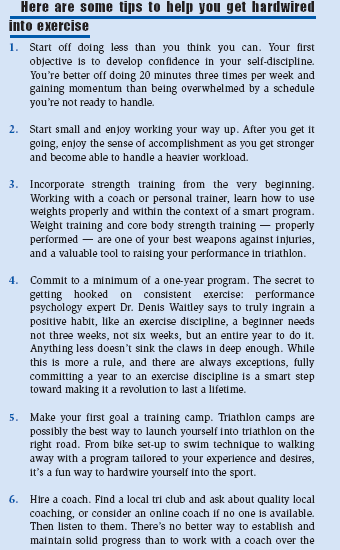
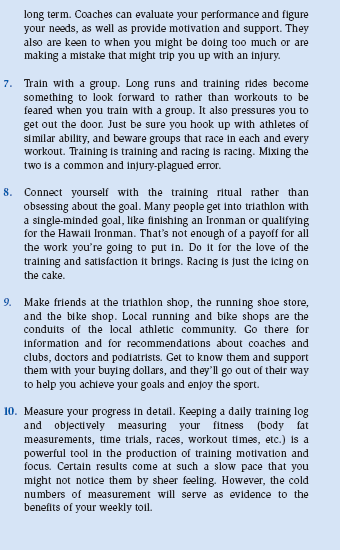

| 2.2 | Heart Rate Monitor 101 |
Almost every triathlon coach or triathlon program somehow or another has you watching your heart rate. It’s the fundamental way a coach can make sure you’re not overtraining, as pumped up beginners often do.
Ultimately, everyone using a heart-rate monitor to guide their training will be interested in a stress test or supervised time trial to figure their maximum heart rate. The following formula will give you a solid, useful start without any of the hassle or expense. And it works. Break out your monitor, grab a pencil, a calculator and notepad, and you’re in business.
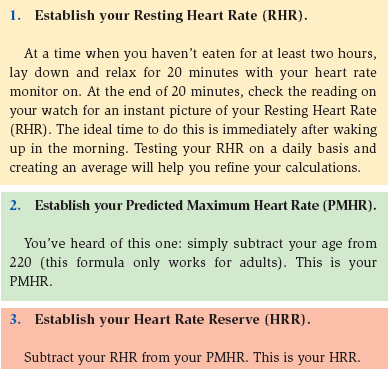
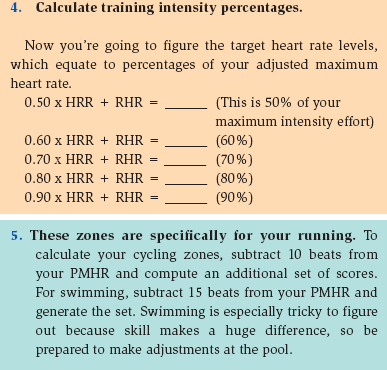

 |
The Energy Efficient or Recovery Zone — 60% to 70% |
Training within this zone develops basic endurance and aerobic capacity. All easy recovery running should be completed at a maximum of 70%. Another advantage to running in this zone is that while you are happily fat burning, you may lose weight and you will be allowing your muscles to re-energize with glycogen, which has been expended during those faster-paced workouts. Check out the fat burning zone page.
 |
The Aerobic Zone — 70% to 80% |
Training in this zone will develop your cardiovascular system. The body’s ability to transport oxygen to, and carbon dioxide away from, the working muscles can be developed and improved. As you become fitter and stronger from training in this zone, it will be possible to run some of your long weekend runs at up to 75%, thus getting the benefits of some fat burning and improved aerobic capacity.
 |
The Anaerobic Zone — 80% to 90% |
Training in this zone will develop your lactic acid system. In this zone, your individual anaerobic threshold is found — sometimes referred to as the point of deflection (POD). During these heart rates, the amount of fat being used as the main source of energy is greatly reduced and glycogen stored in the muscle is predominantly used. One of the by-products of burning this glycogen is the runner’s worst enemy, lactic acid. There is a point at which the body can no longer remove the lactic acid from the working muscles quickly enough. This happens at an individual heart rate for us all and is accompanied by a rapid rise in heart rate and a slowing of your running pace. This is your anaerobic threshold or POD. Through the correct training, it is possible to delay the POD by being able to increase your ability to deal with the lactic acid for a longer period of time or by pushing the POD higher.
 |
The Red Line Zone — 90% to 100% |
Training in this zone will only be possible for short periods of time. It effectively trains your fast-twitch muscle fibers and helps to develop speed. This zone is reserved for interval running and only the very fit are able to train effectively within this zone.
First, you need to know your Maximum Heart Rate (MHR). Be sure to get the all-clear from your doctor before attempting to find your MHR, as it requires an all-out effort. An easy way to do this is with an indoor trainer while wearing your heart rate monitor. Warm up by pedaling easily for 15-30 minutes. Now, increase resistance to a level that you can still pedal without jumping on the pedals. At 60-second intervals, increase either the gear or the resistance a notch. Continue until exhaustion. Record the highest heart rate you attain.
In a study published in a recent issue of The Journal of the American College of Cardiology, Dr. Seals and his colleagues devised a new formula: maximum heart rate equals 208 minus 0.7 times age. They used published studies involving 18,712 healthy people and data from 514 healthy people they recruited. Their formula gives much higher average maximum heart rates for older people, with the new and old heart rate curves starting to diverge at age 40.

The Karvonen Formula calculates your heart rate reserve range. To calculate it, take your pulse for one minute on three successive mornings upon waking. (We will be using the case of a 30-year-old male whose resting pulse was 69, 70 and 71 for an average of 70 over the three days.)

The lower boundary of the percentage range is 50% of this plus your resting heart rate [(120 x 0.5) + 70 = 130]. The higher boundary is 85% plus your RHR [(120 x 0.85) + 70 =172]. Using the Karvonen Formula for percentage of heart rate reserve, this 30-year-old man should be working between 130 and 172 beats per minute (BPM).

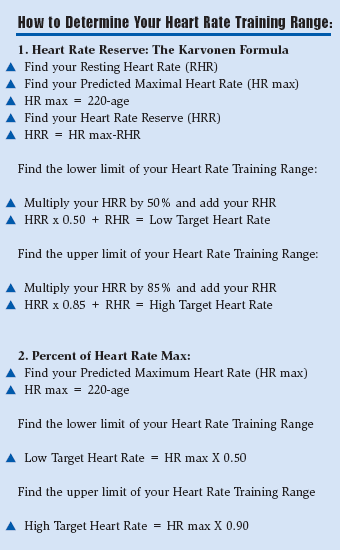
| 2.3 | Getting Your Weight Down Safely |
If there’s one fact that sports scientists, coaches and athletes agree on when it comes to a common trait in top athletes, it’s this: a low body fat percentage. Citing the facts in hundreds of case studies, Dr. Michael Colgan, head of the Colgan Institute and one of the most highly regarded sports nutritionists in the world, is frank: “Body fat is dead weight.”
To prove the point, Dr. Colgan, whose clientele have included the likes of Mark Allen, Dave Scott, Peter Reid and Lori Bowden, begins a session with a new client on the running track. “Yes, we’ve done this for a long time,” Colgan says. “We have them sprint a full lap around the track at their best speed. We give them a chance to completely recover, and then we have them do it again with a 10-pound bodybelt around their waist.” The dramatic effect, Colgan adds, reveals how much body fat erodes athletic performance.
“And that’s just for the quarter-mile,” he says. “For a triathlete out there for hour after hour, the effect is disastrous.”
The upshot of this message is the obvious truth: Those seeking a direct path to a substantial increase in performance are advised to strategically and accurately steer their body fat percentage into an optimum zone.
Ranges both safe and optimal for endurance athletes are as follows: Men 8-12 percent and women 10-15 percent.
After you’ve established that you want to burn off some dead weight, the first thing to do is clarify the common mistakes and pitfalls made by multitudes of athletes before you. Colgan has long said that “often athletes use methods that decimate both their performance and their health.” Studies have shown time and time again that endurance athletes restricting their food intake nose-dive into a state of poor nutrition.
A study of women qualified for the Olympic Marathon trials showed that highly trained runners had low intakes of iron, zinc, copper, magnesium, calcium and overall calories. Colgan says that athletes subsisting on such diets are robbing themselves of the performance their weight-reducing diets are designed to achieve. The currently popular Atkins diet — recently condemned by the government — funded Medical Research Council-may be one of the most visible examples of a fad diet that exacts harm.
“Atkins has fooled people into thinking it’s the answer to life,” says Colgan. “It’s diets like these that are fatally flawed. They’re designed to lose weight rather than correctly lose body fat. You lose it too fast, burn off muscle, and throw the body into a defensive state where it strives to preserve fat.”
In the three decades Dr. Colgan has been advising athletes, he’s established a solid set of guidelines on correctly melting off the unwanted pounds. Below are several of the most essential rules he wrote about in Optimum Sports Nutrition and can be easily put into action by a triathlete in training.

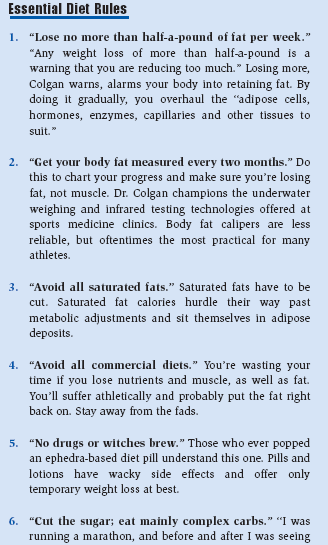
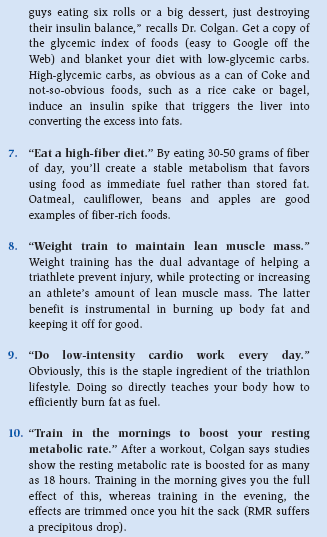
 |
Maintain your Omega-3s and chromium levels. In addition to the 10 methods listed above, Colgan advises athletes to maintain their Omega-3 fatty acid status, which helps your insulin metabolism. Such foods as fresh salmon and nuts are good sources of Omega-3s. He also recommends supplementing with 200-600 mcg chromium picolinate daily to keep your insulin metabolism in check. |
 |
Maintain your mitochondria. Most recently, Dr. Colgan has been studying “excitotoxic brain dysfunction.” Roughly defined as the breakdown of mitochondria by free radicals, Colgan says that between the ages of 26 and 60, there’s a 50 percent natural decline in mitochondria function. The result is the feeling of fatigue, Colgan says, and when we feel tired like this, we often make the mistake of eating more. A key to healthy mitochondria is to supplement with acetyl-L-cartinine (500-2000 mcg per day) and R+ alpha lipoic acid (100-800 mg per day). |
 |
Kick up your anabolic drive with doubles. A natural for triathletes, by training two times per day, you’ll burn body fat and increase lean muscle. |
Fortunately for triathletes, the essential lifestyle alone is a great burner of body fat. But don’t forget optimal nutrition strategies offered by certified experts, such as Dr. Colgan. You’ll not only lose the pounds, you’ll lose the right pounds.